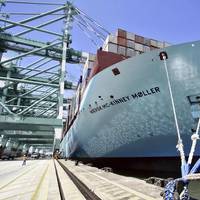Teekay Expects Recovery in Tankers Market
Crude tanker rates have continued to strengthen during the early part of the fourth quarter of 2018, particularly in the Atlantic Basin with Aframax tanker rates in this region attaining levels not seen since December 2016 and Suezmax tanker rates averaging the highest since March 2017, says Teekay Tankers.The conventional tanker fleet operator said that crude tanker spot rates firmed counter-seasonally during the third quarter of 2018, which is typically the weakest quarter of the year, as higher OPEC and Russian oil production, coupled with strong crude oil exports out of the U.S. Gulf, offset the impact of seasonally lower oil demand.Crude tanker rates during the third quarter of 2018 averaged higher than rates in the second quarter for the first time since 2014…
Big Data Helps Shippers Cut Fuel Bills, Emissions

By focusing on operational improvements, shipping companies are reducing fuel consumption, saving money and cutting greenhouse emissions, while continuing to increase the amount of freight transported. Maersk Line, the world's largest container carrier, cut fuel consumption by more than 13 percent between 2012 and 2014, while increasing the number of boxes carried by 11 percent, according to company records. Maersk's fuel savings amount to 1.35 million tonnes of fuel per year - and 1.5 million tonnes per year if the increase in freight volumes is taken into account.
Brent eases below $108 on Ukraine diplomacy
EU leaders set to warn, not sanction Russia; U.S. crude stocks rise more than expected. U.S. jobs data, services data point to lower oil demand. Brent crude reversed gains made earlier on Thursday after Crimea's parliament voted unanimously to join Russia, even as the West and Russia engaged in high-stakes diplomacy to cool the crisis in Ukraine. The announcement sets a referendum on the future of Crimea in 10 days, raising the stakes in the most serious East-West confrontation since the end of the Cold War. The North Sea benchmark has fallen $4 since reaching two-month highs on Monday, when worries of an armed conflict between Ukraine and Russia peaked.
Why Tankship Trade to U.S. is in LImbo
Increasingly lower oil demand in the U.S. prompts tankship operators to look towards the China market. According to a BIMCO review, the tanker market is doing full steam ahead – not in relation to demand, earnings or actual operating speed, but in relation to structural demand changes in the West. At the epicentre of this is the world’s most thirsty oil consumer: the U.S. Not to be missed by anyone, the U.S. oil demand recorded a 16-year low in 2012. In 2005, the U.S. consumed 20.8 million of barrels per day (m/bpd), in the same year the domestic oil production stood at 5.2 m/bpd. Today 18.6 m/bpd is consumed, 6.5 m/bpd is produced and imports of Canadian oil are the growth story. Coincidentally with a lower and lower oil demand in the U.S., the U.S.
IEA: Oil Demand to Grow 2.2% in 2005
The International Energy Agency’s most recent monthly report estimates for 2005 that global demand will grow by 1.8 mb/d, or 2.2%. for 2004. The 2005 demand estimate assumes: normal weather, a moderate slowdown in global GDP growth, an easing of crude oil and product prices and a modest reduction in Chinese oil consumption growth. Even so, Chinese oil demand is expected to grow by 510 kb/d, or 8.1% in 2005. The Middle East is also expected to contribute strong consumption growth in 2005 of 260 kb/d or 4.7%. These high growth rates contrast with substantially lower oil demand growth in the OECD of slightly less than 1% in 2005, holding flat in OECD Asia but rebounding slightly in OECD Eastern Europe.
EIA Expects OPEC Output to Continue to Rise
The U.S. Energy Information Administration expects OPEC countries to continue producing above their quotas, pushing the cartel's average output 770,000 bpd above official levels for the quarter. OPEC's actual production would also be just 619,000 bpd lower during the first quarter from output levels at the end of last year, the agency said in its monthly OPEC update. That would be much less than the 1.5 million bpd that OPEC members (excluding Iraq) agreed to cut from their production quotas during a meeting last month in Vienna. The cartel set its production at 25.2 million bpd beginning Feb. 1 in order to stop oil prices from falling from what is expect to be lower oil demand in the first half of this year.
EIA Expects OPEC Output To Rise
The U.S. Energy Information Administration expects OPEC countries to continue producing above their quotas, pushing the cartel's average output 770,000 barrels per day (bpd) above official levels for the quarter. OPEC's actual production would also be just 619,000 bpd lower during the first quarter from output levels at the end of last year, the agency said in its monthly OPEC update. That would be much less than the 1.5 million bpd that OPEC members (excluding Iraq) agreed to cut from their production quotas during a meeting last month in Vienna. The cartel set its production at 25.2 million bpd beginning Feb. 1 in order to stop oil prices from falling from what is expect to be lower oil demand in the first half of this year.





